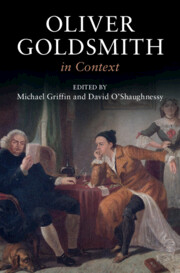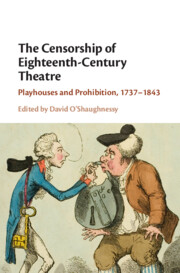125 results

Oliver Goldsmith in Context
- Coming soon
-
- Expected online publication date:
- August 2024
- Print publication:
- 31 August 2024
-
- Book
- Export citation
Figures
-
- Book:
- The Censorship of Eighteenth-Century Theatre
- Published online:
- 03 August 2023
- Print publication:
- 17 August 2023, pp ix-x
-
- Chapter
- Export citation
Abbreviations
-
- Book:
- The Censorship of Eighteenth-Century Theatre
- Published online:
- 03 August 2023
- Print publication:
- 17 August 2023, pp xvii-xviii
-
- Chapter
- Export citation
Part II - Politics
-
- Book:
- The Censorship of Eighteenth-Century Theatre
- Published online:
- 03 August 2023
- Print publication:
- 17 August 2023, pp 93-152
-
- Chapter
- Export citation
Acknowledgements
-
- Book:
- The Censorship of Eighteenth-Century Theatre
- Published online:
- 03 August 2023
- Print publication:
- 17 August 2023, pp xv-xvi
-
- Chapter
- Export citation
Part III - Performance
-
- Book:
- The Censorship of Eighteenth-Century Theatre
- Published online:
- 03 August 2023
- Print publication:
- 17 August 2023, pp 153-240
-
- Chapter
- Export citation
Dedication
-
- Book:
- The Censorship of Eighteenth-Century Theatre
- Published online:
- 03 August 2023
- Print publication:
- 17 August 2023, pp v-vi
-
- Chapter
- Export citation
Introduction
-
-
- Book:
- The Censorship of Eighteenth-Century Theatre
- Published online:
- 03 August 2023
- Print publication:
- 17 August 2023, pp 1-30
-
- Chapter
- Export citation
Part I - Gender
-
- Book:
- The Censorship of Eighteenth-Century Theatre
- Published online:
- 03 August 2023
- Print publication:
- 17 August 2023, pp 31-92
-
- Chapter
- Export citation
Contributors
-
- Book:
- The Censorship of Eighteenth-Century Theatre
- Published online:
- 03 August 2023
- Print publication:
- 17 August 2023, pp xi-xiv
-
- Chapter
- Export citation
Copyright page
-
- Book:
- The Censorship of Eighteenth-Century Theatre
- Published online:
- 03 August 2023
- Print publication:
- 17 August 2023, pp iv-iv
-
- Chapter
- Export citation
Index
-
- Book:
- The Censorship of Eighteenth-Century Theatre
- Published online:
- 03 August 2023
- Print publication:
- 17 August 2023, pp 257-262
-
- Chapter
- Export citation
Contents
-
- Book:
- The Censorship of Eighteenth-Century Theatre
- Published online:
- 03 August 2023
- Print publication:
- 17 August 2023, pp vii-viii
-
- Chapter
- Export citation
Bibliography
-
- Book:
- The Censorship of Eighteenth-Century Theatre
- Published online:
- 03 August 2023
- Print publication:
- 17 August 2023, pp 241-256
-
- Chapter
- Export citation

The Censorship of Eighteenth-Century Theatre
- Playhouses and Prohibition, 1737–1843
-
- Published online:
- 03 August 2023
- Print publication:
- 17 August 2023
Chapter 5 - Metropolitan Theatre
- from Part II - Transitions
-
-
- Book:
- Irish Literature in Transition, 1780–1830
- Published online:
- 28 February 2020
- Print publication:
- 12 March 2020, pp 107-121
-
- Chapter
- Export citation
Chapter 10 - Radical Societies
- from The French Revolution Debate
-
-
- Book:
- Mary Wollstonecraft in Context
- Published online:
- 16 January 2020
- Print publication:
- 06 February 2020, pp 87-94
-
- Chapter
- Export citation
Index
-
- Book:
- Ireland, Enlightenment and the English Stage, 1740-1820
- Published online:
- 22 July 2019
- Print publication:
- 01 August 2019, pp 259-268
-
- Chapter
- Export citation
Select Bibliography
-
- Book:
- Ireland, Enlightenment and the English Stage, 1740-1820
- Published online:
- 22 July 2019
- Print publication:
- 01 August 2019, pp 249-258
-
- Chapter
- Export citation
Contributors
-
- Book:
- Ireland, Enlightenment and the English Stage, 1740-1820
- Published online:
- 22 July 2019
- Print publication:
- 01 August 2019, pp x-xii
-
- Chapter
- Export citation



